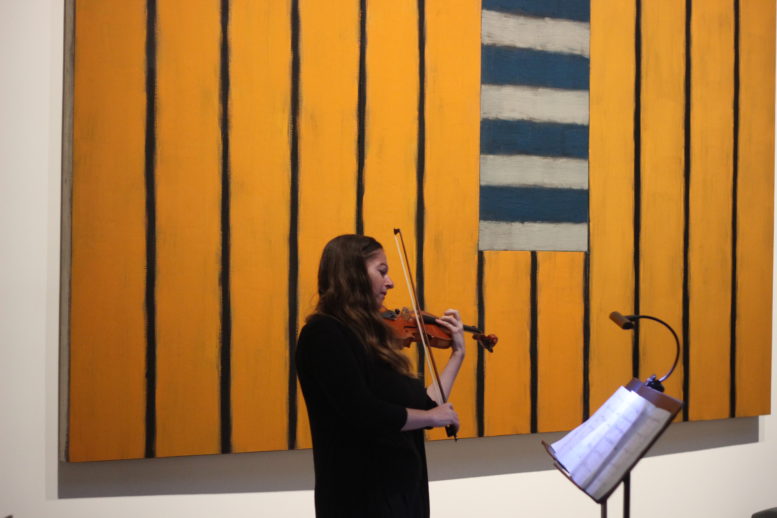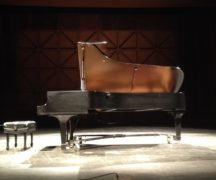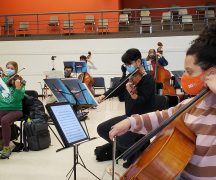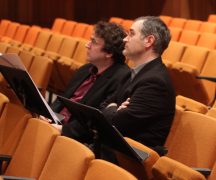By DAVID DUPONT
BG Independent News
Joe Klingler didn’t spend a lot of time at Bowling Green State University.
He studied composition with Marilyn Shrude for a year, 1990-1991, as well as taking courses with Burton Beerman. He already had several degrees in engineering and music from the University of Toledo and then founded a software company. That pulled him away from his graduate studies in music, and deeper in the world of technology.
Now he lives in California and writes thrillers. Not surprisingly, those always have a musician as a character and technology figuring in the plot.
He’s still plugged into BGSU. Five years ago, at the suggestion of BGSU composition professor and electro-acoustic composer Elainie Lillios, Klingler funded a residency program for composers of electro-acoustic composers. Once in fall and once in spring, a composer will come and spend two weeks on campus, working in the university’s Multichannel Ambisonic studio and working with composition students.
Klingler says he’s a strong believer in the importance of these personal relationships in education.
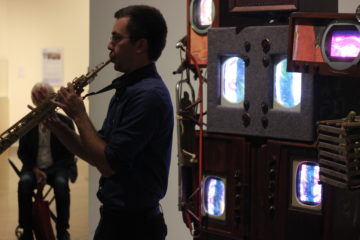
Christopher Murphy performs near Nam June Paik’s “Beuys Voice”
This weekend the BGSU College of Musical Arts is celebrating the fifth anniversary of the founding with performances and workshops.
The event culminates tonight (Saturday, Sept. 16) with a concert in Kobacker Hall featuring work by the eight composers who have been residents as part of the Klingler Electro-Acoustic Residency. The composers are:
Adam Basanta, Brad Garton, John Young, Jonty Harrison, James Andean, Louise Harris, Adrian Moore, and Robert Normandeau.
Most of the compositions, Lillios said, will be multi-channel works. Using speakers arrayed around the hall, the composers will surround listeners with music. One piece will employ live performers interacting with electronics, and another uses video.
All this just touches on the possibilities of the genre.
Electro-Acoustic music as its name implies use electronic and digital sounds, sometimes, but not always, with live musicians. Those recorded sounds can be anything from traffic to bird calls or sounds generated by the machines themselves, and all digitally manipulated in innumerable ways.
A sample of the work was heard during the first Ear/Eye performance at the Toledo Museum of Art Friday night.
The series opened its third season. Students from the Doctorate in Contemporary Music program perform new music in the museum’s galleries, pairing compositions with a specific works of art.
Two of the four pieces performed Friday were by KEAR alumni.
“Fields of Darkness and Light” by Adrian Moore was played by violinist Anat Kardontchik performing over digitally manipulated snippets of violin sounds. The piece was presented in front of Sean Scully’s painting “Ookbar.”
The concert concluded with a small ensemble of musicians performing James Aldean’s “To Then the None miniature” in front of Paik’s robotic portrait “Beuys Voice.”
The piece was a conversation between the ensemble, and shards of language. The clips represented different languages, but all that was uttered were bits of syllables. The musicians responded with improvised breathy tones and tinkling percussion. The piece was performed by Kenneth J. Cox, flute, Derek Emch and Hila Zamir, clarinets, Christopher Murphy, saxophone, and Nicholas Fox, percussion. Nathan Haering and Stephen Hennessey operated the electronics for the two pieces.
Klingler who was on hand for the concert said he finds the music produced by electro-acoustic composers to be “wildly experimental and increasingly interesting.”
His interest in electronic music stems back to his love of Jimi Hendrix and other rock performers from the 1970s. He started on guitar before switching to keyboards. He said he had a closet full of synthesizers at one point. He also studied classical piano with Frances Renzi. Though his career moved in different directions his interest in experimental music hasn’t faded.
“I’m kind of a research guy, and to me this is research.”

